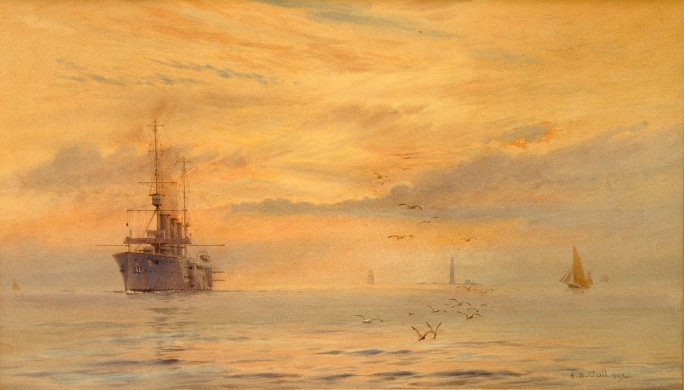HMS CORNWALL off the Eddystone, 1923
Alma Claude Burlton Cull (1880-1931). watercolour signed and dated 1923 (lower right).
20 x 11 inches (51 x 29 cms) approx
price on application
This original has been sold and is no longer available.
Another classic Cull with its placid, delicate water and finely painted, gloriously colourful sky: and whispering gently along with the Eddystone lighthouse a mile or so off her port quarter, one of His Majesty's Ships, HMS CORNWALL.
One of ten Monmouth Class armoured cruisers built between 1901 and 1903, CORNWALL (the sixth of the name in the Royal Navy, the first dating from 1692) displaced some 9.800 tons, had a length overall of 448 feet and carried a main armament of fourteen 6 inch guns with a host of smaller calibre weapons and torpedoes. 22,000 shp gave her a maximum speed of about 23 knots and on her sides she was armoured with a 4 inch belt. BEDFORD of the class was wrecked on the China staion in 1910 and MONMOUTH was lost with all hands in the SW Pacific in October 1914 at Graf Spee's hands, although sister ships KENT and CORNWALL were able to avenge this loss off the Falklands 2 months later in December 1914. CORNWALL was finally decommissioned in 1920. Since then there have been two further CORNWALLs - the County Class cruiser of 1926 sunk in the Indian Ocean in 1942; and the frigate of 1985 who was prematurely decommissioned in 2011, an act of folly by a government hell bent on defence cuts whatever. CUMBERLAND of this class (painted by Frank Watson Wood) is also featured on this website (MP207): Wood was some 16 years older than Alma Cull but the two were painting the same type of subjects, albeit in different styles, for some 30 years until Cull's death in 1931.
Eddystone is perhaps Britain’s best known lighthouse probably because its built on a small and dangerous rock 13 miles SW of Plymouth and has a fascinating history! Work first started on placing a light on this rock in 1698 and after several not very successful attempts by Henry Winstanley had been made for a permanently serviceable all weather light to mark the rock, John Rudyard finally managed with a wooden tower which stood for 47 years until on the night of 2 December 1755 when it burned down. John Smeaton was the next to have a go in 1756 and his tower of stone lasted for 120 years before cracks necessitated its closure: the top half was re erected as a monument to the builder on Plymouth Hoe, the stump remaining on the rocks to this day and clearly shown here by the artist. The present lighthouse built by Douglas dates from 1892; it was the first of Trinity House’s lighthouses to be automated and was re-commissioned by HRH The Duke of Edinburgh in May 1982.
Fortunately for us Cull was clearly besotted with the capital ships of the day and he painted them all beautifully: wonderfully accurate draughtsmanship of their towering and graceful structures and always set in the most competently portrayed seas and skies. These it seems he determined to show in some of their most complicated and testing patterns and forms - and always he succeeded superbly, this watercolour being no exception with its translucent colours and delicately executed sky.
